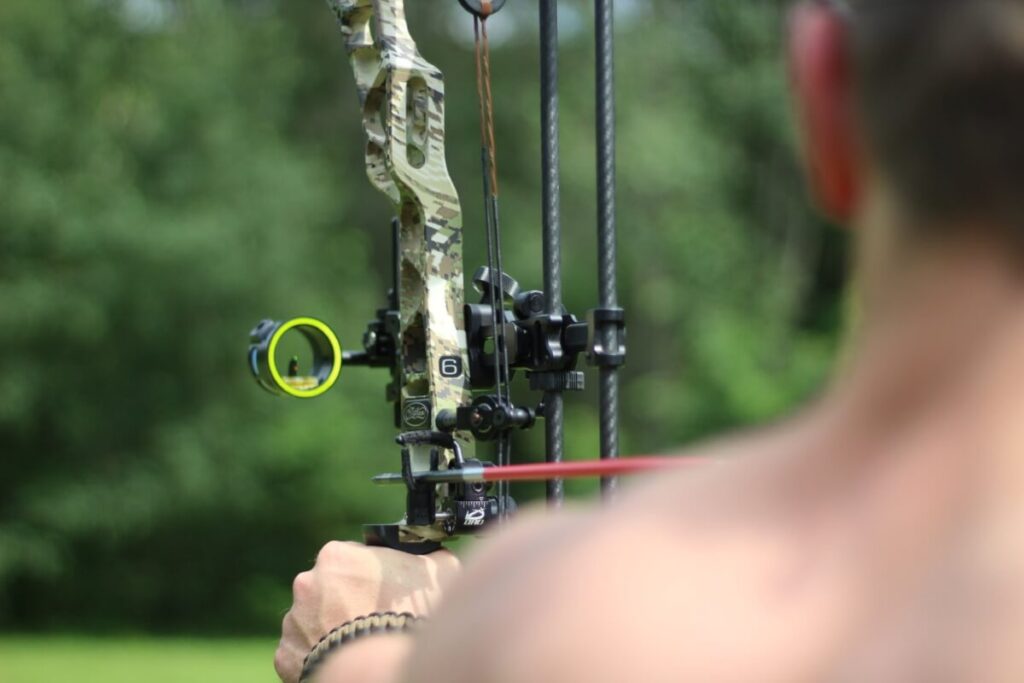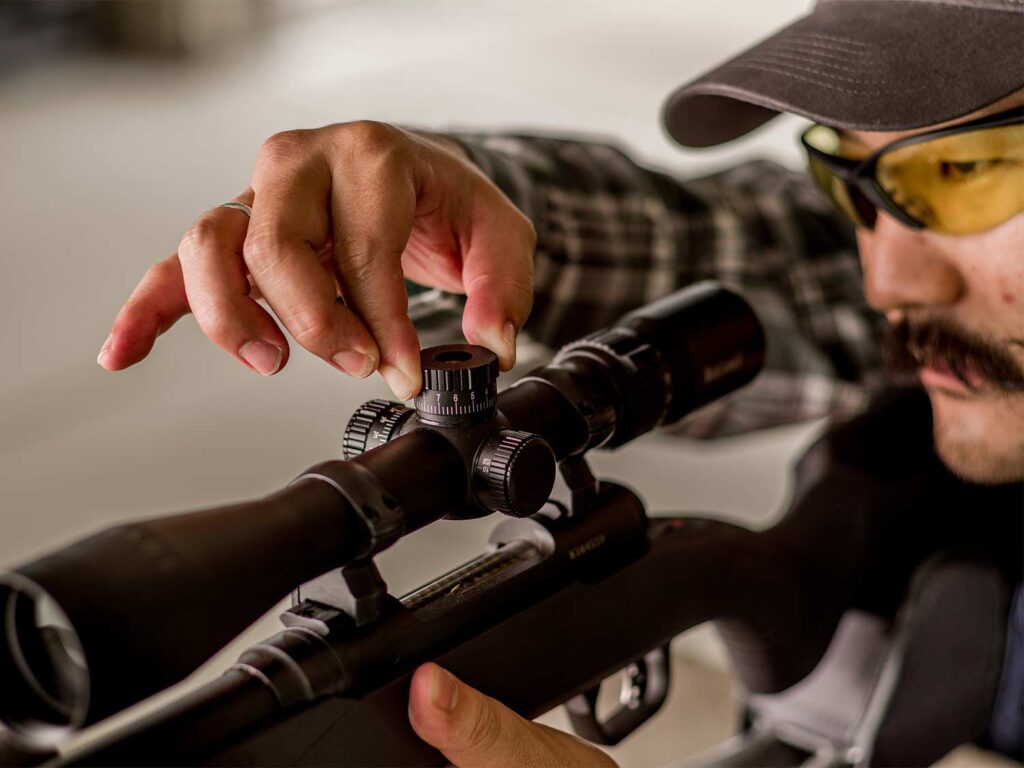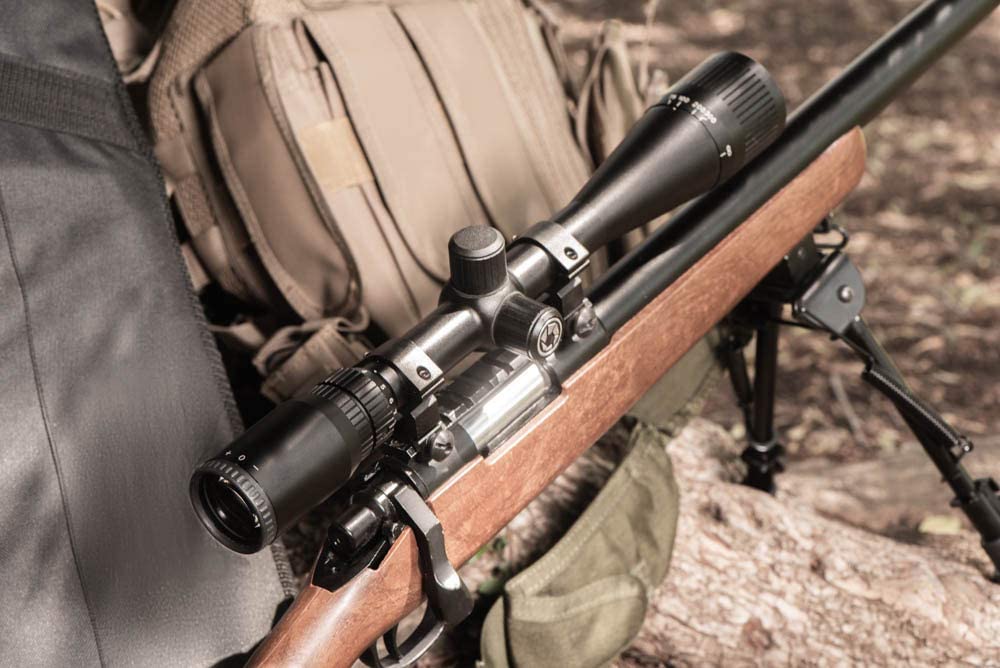

Made to be used by snipers, today the mil-dot scope has been adopted by sports disciplines that take advantage of the long-range benefits it provides.
They have a series of points that are located on the lines of the reticle. They are separated by a distance measured in milliradians. The best mil-dot scopes make the estimation of targets easier and more accurate.
If you’re a long-range shooter, you need to have one. This is why we’ve helped you aggregate the seven best mil-dot reticle scopes on the market. We’ll look at their build quality, adjustability, type of mil-dot reticle, and optics, as all this greatly impacts the final image and spotting ability.
More features: second focal plane; HiLume multi-coating lens; waterproof and fog-resistant
Burris Fullfield II 6.5–20×50 rifle scope has a modern reticle with a cascading drift and elevation points. This allows you to shoot at long distances (up to 500 yards) in both calm and windy conditions.
The high-quality optical glass is precision cut. The lenses are coated several times and thus offer glare protection and maximum performance when hunting in unfavorable light conditions.
The Fullfield 6.5–20×50 mm riflescope is characterized by its slim design. It has improved drift and altitude buttons and hinged lens caps can be used for the separate ring light and the eyepiece.
The riflescope consists of a one-piece tension-free tube. Its inner part is double spring-tensioned and thus makes the rifle scope shockproof.
The design of the separate ring light and the eyepiece enables the use of a hinged lens cover. The double, internal spring-tension system enables the rifle scope to hold the zero point in the event of bumps, recoils, and vibrations. It has precise adjustment mechanisms made of steel, ensuring repeated accuracy.
More features: fully coated optics; multi-range parallax setting adjustments; waterproof, fogproof, and shockproof
Barska 3–12×40 AO Air Gun Riflescope is designed for field use and can withstand heavy recoils and violent vibrations from airguns. It’s made for hunting enthusiasts who want a simple, yet sophisticated reticle for maximum accuracy.
The drift and height buttons, which can be adjusted at the touch of a finger, ensure a slim profile. The button displays always indicate a change in the meeting point and thus ensure target accuracy.
The nitrogen-filled pipes prevent internal fogging, even in the cold and rain. The stable, tension-free, and solid one-piece outer tube withstands shocks and vibrations even when using calibers with the strongest recoil.
It has high-quality optical glass for optimal brightness and clarity with a long service life at the same time. When set at 3x, you have a field of view of 35 at 100 yds. When set at the maximum (12x), you have a field of view of 9 at 100 yds.
More features: rear focal plane; ¼-MOA field-click adjustments; Twilight Light Management System
The Leupold Mark 4 spotting scope is built for hunters, recreational shooters, and people in the forces. It is issued for Special Forces or observation or sniper units in the US military branches or Special Forces police units.
This has a magnification from 12 to 40 and the objective lens measures 60 mm in diameter. It’s excellent for gathering light for night situations.
It is extremely lightweight, medium-sized and it’s pretty much very portable. It does not have the most exotic look but it’s built much for military and police use. It’s all in black matte and is completely rubberized, gritty, shockproof, and waterproof.
More features: second focal plane; exposed, finger-adjustable windage and elevation turrets; 12 brightness settings; fog-resistant and waterproof; shockproof
The 4 to 16 by 44 mm second focal plane is made by Primary Arms Optics. It was established in 2007 with a vision to provide customers with affordable but quality optics. With time the company has expanded and is now one of the leading manufacturers of optics.
For that price, you will find that it is quite sturdy and robust. If you look at the turrets, you can see that these are tactical turrets. They are not capped but are open and also quite protruding.
What’s interesting is that these turrets are lockable. They are counterclockwise turrets: both windage and elevation. So, rotating the elevation turret to the left will move the point of impact up the crease. The clicks are also crisp and inaudible.
You also get a parallax adjustment here with a side focus. It can be set from 10 yards up to the Infinity.
It is a scope with a red illuminated mil-dot reticle. The illumination is powered by a battery that is inserted in the eyepiece part.
More features: fully multi-coated optics; external target turret; second focal plane; waterproof and fog proof
The Barska 1 to 4 by 28 mm scope is a good budget optic. It’s a variable zoom optic which is nice because it does give you some good range for shooting out longer shots.
Something nice and one of the first things that you’ll notice about this scope on 1x when you’re looking through it is that: it’s very clear, very bright and the eye relief on it is good. Also, it’s very forgiving.
One of the first things that you’ll notice when you open up the box for this scope is that it has very nice and big turrets. Being lockable, you can twist-unlock or lock.
It has a very nice illuminated reticle that goes from 1 to 5. On 5 and in the sun, you get a tinted reticle scope, not an illuminated reticle scope. It’s very great especially at 1x. When you’re getting it on target, it produces a crisp and clear image.
But when it’s at 1x, it’s more just like a red dot staring down a tube. You can leave both eyes open, see everything very nice and clear. But it’s just that you’re looking down a tube. So, you can’t move too far off to the left or the right.
More features: second focal plane; 11-layer fully multi-coated optics; 100 MOA adjustment range; fast focus eyebell; all caliber rated
The Hawke Vantage 3–9×40 scope works wonders on small arms like a .22 LR rifle, .17 HMR rifle, or even a PCP rifle.
It is an optic superior in comfort to the 4×32 encountered on recreational weapons. Its intermediate magnification allows visualizing a target at 50 meters with more detail.
The optical quality is there: the image is clear and bright. You can also adjust the sharpness of the image according to the chosen magnification and your shooting distance thanks to the parallax adjustment ring.
The magnification can go from 3x to 9x, with a 40mm lens for a wide field of view. The actual outer diameter is 54mm.
It features a Mil-Dot reticle facilitating the estimation of dimensions or the compensation of the fall of the projectile.
There is a parallax adjustment by a ring placed on the objective. You can thus adjust the sharpness of the image according to your shooting distance.
You can make windage and height adjustment by clicks of 1/4 MOA (1 click = displacement of the point of impact from 7 mm to 100 m).
More features: 30 MOA at 100 yds; rubber armor; multi-coated lens; adjustable brightness settings
The Barska ARX scope comes with an illuminated reticle. It is noticeably more compact than the others we’ve reviewed here. It was designed for the AR-15 platform.
With the ARX Mil-Dot reticle, this innovative scope provides accurate targeting even in low-lighted conditions. This is thanks to its reticle which comes in red and green illumination color options. Moreover, its brighten setting is adjustable.
With the multi-coated lens, the ARX tactical scope delivers great optical clarity. It’s ideal if you need fast target acquisitions whether for close or medium range distances.
Most importantly, it is waterproof, shockproof, and fog proof. So, you can take it anywhere, in any weather condition.
A mil-dot reticle scope is an asset to any hunter or forceman. In this guide, we’ll explain to you what Mil-Dot is, how they function, what their advantages are and how to choose a scope with a mil-dot reticle.
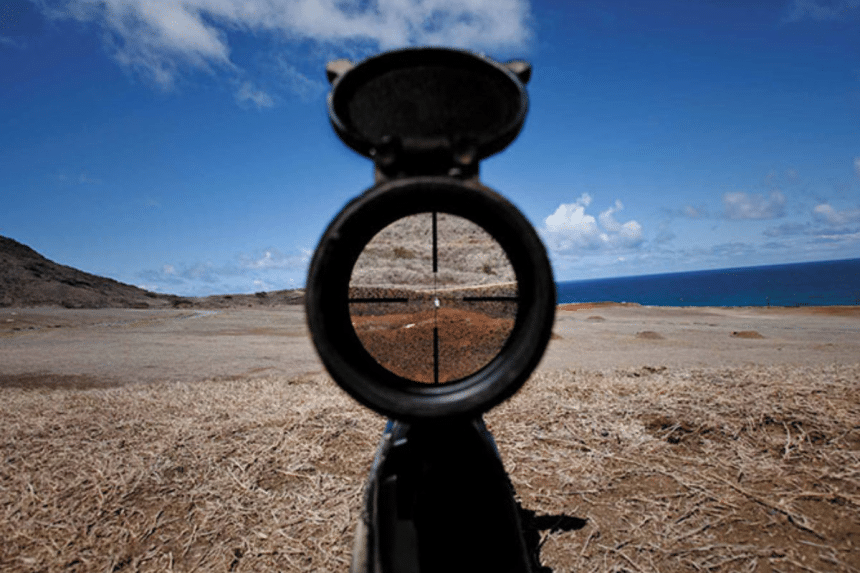
The principle of its use is found in a series of points that are located on the lines of the reticle. They are separated by a distance measured in milliradians. Hence its name Mil, short for milliradians, and Dot, which means points.
The number of reference points is usually five above center, five below center, and equal amounts for left and right. This gives a measurement range of ten milliradians in total from top to bottom and ten milliradians from left to right, also in total.
The most widely used mil-dot reticle in the field of sports shooting is the US Army type, with round points, since it is easier to read on the ground. To calculate the distance between the shooter and the target, it is necessary to estimate the size of the latter as closely as possible.
Suppose we are shooting at a target that we know or calculate is one meter high. Observing through the sight, you see how many dots (points) of the grid it occupies.
You simply have to multiply the height of that target by a thousand and divide it by the number of points it occupies on the grid. In this way, you will obtain the distance at which the objective is.
It seems simple, but it generally requires a calculation and an estimate of the size of the target and the dots it occupies as accurately as possible if we are to be successful.
Scopes with this reticle have been one of the most used by most of the world’s elite shooters, both in the military and in the police field.
Like many other developments made for tactical/military activities, the Mil-Dot has also been adopted for various sports disciplines.
The rise of disciplines in which shooting at targets placed at extreme distances have popularized this type of reticle for sporting sights. It’s generally suitable in supports in which it is necessary to take into account several parameters, among which is the distance to the target.
It is also frequently used in pneumatic weapons for field target practice, where targets located at variable distances are shot.
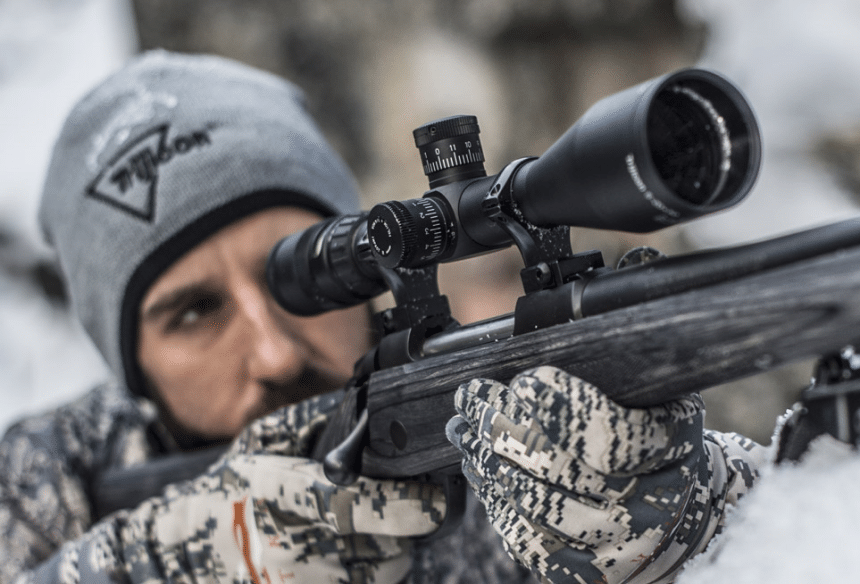 Advantages of a mil-dot scope
Advantages of a mil-dot scopeSome of the advantages of a mil-dot scope are that:
There are a few factors and features that can determine whether you will be completely satisfied with your new mil-dot riflescope. You can choose your scope models very precisely based on the following aspects, which we will explain to you in detail below:
Regardless of the brand, the build quality and optical quality of scope depend on its price. You will only get what you pay for. A scope can be made of hard plastic or aluminum. However, the quality of components such as the rubberization of delicate parts will go a long way in ensuring the item is rugged, durable, and shockproof.
The build quality doesn’t only refer to the visible construction. High-quality riflescopes have a coated optics, a lens coating, also known as an anti-reflective coating.
To achieve this, the glass surfaces are vaporized in several layers with extremely thin coatings, which have a reflection-reducing property.
By reducing the reflection, the loss of light at the gas-glass transition is greatly reduced. In this way, a light transmission of more than 90 percent can be achieved at the transition layer. However, these values are only achieved with high-end scopes.
Both the Hawke Vantage 3–9×40 and the Barska ARX Riflescope are fully multi-coated.
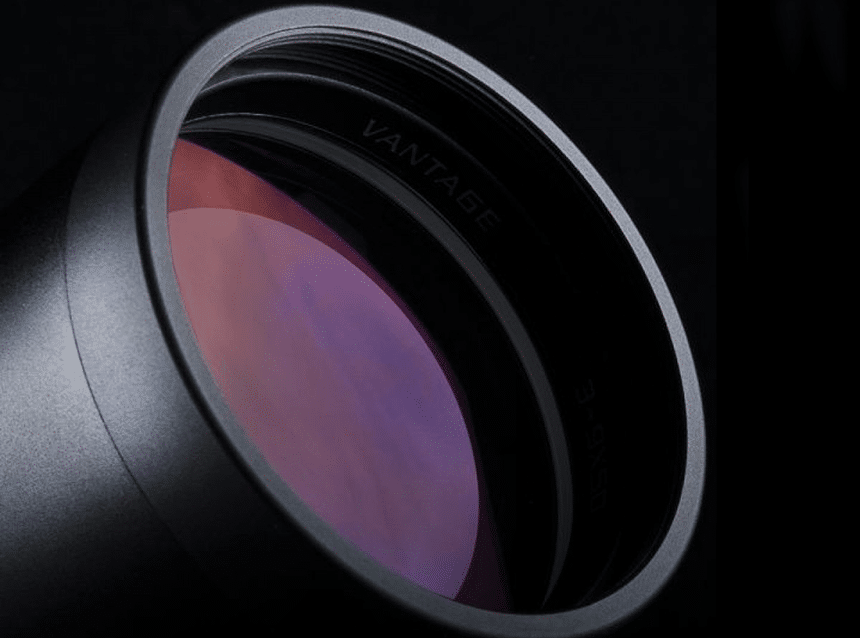
Riflescopes are named after the parameters: magnification and lens diameter. The designation 20 x 50 in the Burris 6.5–20x50mm FullField II means, for example, a maximum of 20x magnification and an objective diameter of 50 mm.
The values of 6.5–20 x 50mm denote optics with variable magnification from 6.5x to 20x and an objective diameter of 50mm. The first number before the “x” denotes the magnification, the second number after the “x” the lens diameter.
The objective diameter is specified in millimeters (mm) and determines how much light is absorbed by the objective of a riflescope. It is therefore responsible for the image brightness in addition to the magnification and the lens coating. The effective lens diameter changes with glasses with variable magnification according to the focal length.
The larger the diameter, the more light can enter the optics. Doubling the lens diameter results in a quadrupling of the amount of light. The lighting conditions are therefore an important consideration when choosing the lens diameter.
During the day with a clear view, a lens diameter of 25mm works with 10x magnification at 165 yards, in twilight and moonlit nights a large lens diameter ensures higher image brightness and better contrasts.
The Leupold Mark Tactical Spotting Scope, with 60mm, has the biggest objective diameter among the reviewed seven. Meanwhile, the Barska 1–4×28 Riflescope has the smallest diameter of 28 mm.
You cannot physically place the crosshairs of riflescopes on the target object to avoid a parallax error. This is also not necessary as the lens creates an image of the target object inside the pipe.
If the reticle is mounted in the lens image plane, the two image planes of the target object and crosshair lie together and there is no parallax error.
In a good riflescope with parallax setting adjustment like the Barska AO Air Gun Riflescope, the parallax is set to a certain distance by shifting the lens or reticle. Hence, the position of the reticle will not shift even if the view into the optics is changed.
The field of view is the space that can be seen at a certain distance. It is the viewing angle. In the case of riflescopes, the calculation basis is usually 100 yards away. The field of view is specified in feet or degrees (viewing angle). The larger the field of view, the easier it is to track moving target objects and observe large objects.
If you want to compare the field of view of different riflescopes, the optics must have the same or almost identical magnification.
In general, the quality of a magnifying glass should only be determined by considering the field of view and the edge sharpness together. Inferior quality optics from the low price range are sometimes advertised with a large field of view, which, however, is only made possible by a reduced edge sharpness. Likewise, a provider can advertise with excellent edge sharpness, which, however, can be at the expense of the field of view, so both features are in a direct relationship to one another.
The reticle is the marking in the rifle scope, the crosshair, or the luminous point. There are different designs for different purposes. For example, reticles for hunting purposes differ from those for military or police precision shooters and sport shooters.
There are also different designs within the various areas of application, e.g., for estimating distances or for use in twilight or night hunting.
To represent the reticle, two threads are drawn orthogonally to each other. To do this, a wire is inserted into the glass, or the markings are etched in. In this way, further markings can be made, which play an important role in assessing the distance (e.g., angular units).
To be able to recognize the marking on the target object better in twilight or on a bright moonlit night, there are scopes with an illuminated reticle.
The lighting is supplied either electrically from batteries or by natural light.
Usually, with red, green, or black options, the Barska ARX Riflescope and the Barska 1–4×28 Riflescope are two examples of illuminated scopes.
Many optics have, for example, a multicolor reticle with 36 colors, so the reticle can be adapted to any background.
Meanwhile, there are some like the Hawke Vantage 3–9×40 which have no illumination whatsoever.
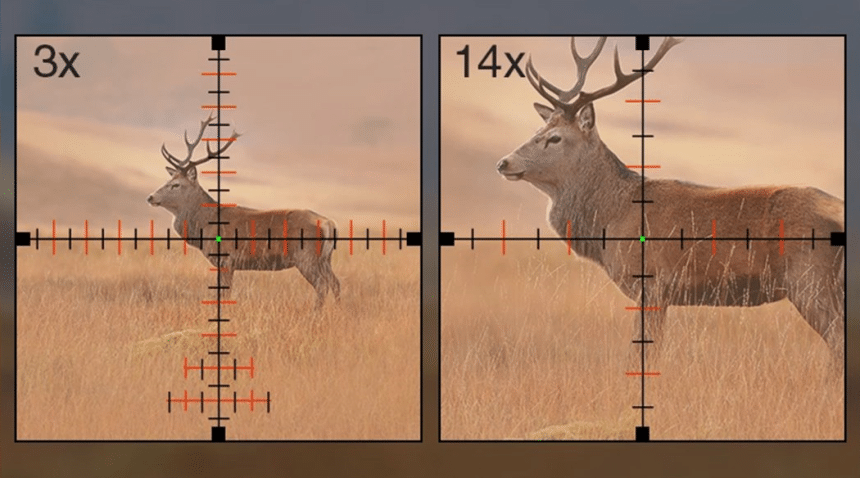 Waterproof and fogproof design
Waterproof and fogproof designA scope that is well built is usually weatherproof, that is, it can be used in all weather and cannot be affected by fog or water. You can choose well-built scopes like the Barska AO Air Gun Riflescope or the Burris 6.5–20x50mm FullField II. They’re very resistant to shock, fog, and water.
Rated 9/10 by our experts, the Burris 6.5–20x50mm FullField II is our Editor’s Choice. This rifle scope has a modern reticle with a cascading drift and elevation points. This allows you to shoot at long distances in both calm and windy conditions.
Our best value product, the Barska AO Air Gun Riflescope is rated 9.7 out of 10. This riflescope is designed for field use and can withstand heavy recoils and violent vibrations from airguns.
Our Upgrade Pick is the Leupold Mark Tactical Spotting Scope. One of the best Mil-Dot scopes on the market, this spotting scope is built for hunters, recreational shooters, and people in the forces. It is also rated 9.7 out of 10.
